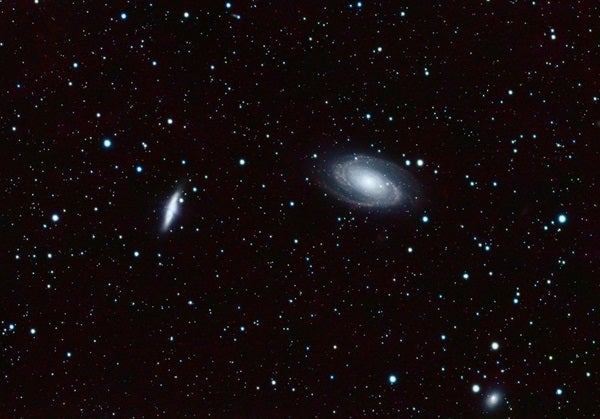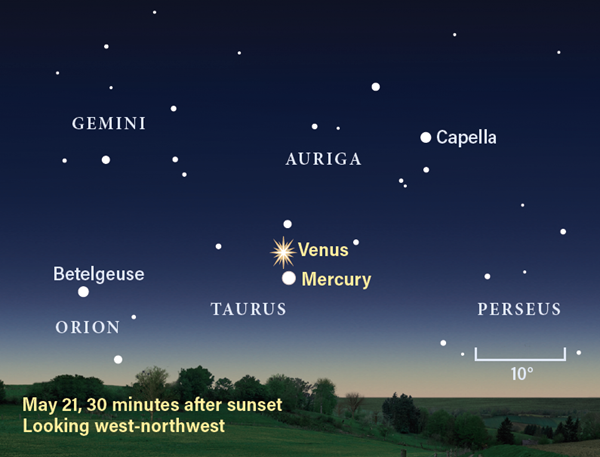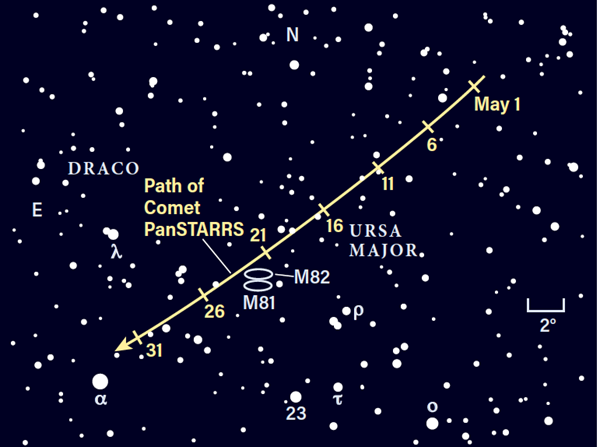Asteroids 23 Thalia and 40 Harmonia share a relatively small region of the sky this month. To see them tonight, find Virgo’s bright star Spica above the southern horizon after dark. Slide your gaze 15° east to 4th-magnitude Iota (ι) Virginis. Look 5° west of Iota, and you’re smack-dab in the middle of an imaginary line running southwest between Thalia and Harmonia. Tonight, the two are 2.2° apart, with Harmonia farther southwest than Thalia. Both of these main-belt asteroids are roughly 67 miles (108 kilometers) across. If you return to this region at the end of the month, you’ll find that Thalia has moved about 2° southwest, appearing to chase after Harmonia, which has slid roughly 2° due west.

Astronomy is pleased to present The Complete Star Atlas, the perfect resource for stargazers of all ages. This practical guide to viewing the night sky includes approximately 87,000 stars, 1,200 deep-sky objects, and 24 high-quality star maps. You’ll also find 50 pages of astronomy history, tips, and more from experienced Contributing Editor Michael E. Bakich.
The Moon passes 4° south of Neptune at 11 A.M. EDT. Two hours before sunrise, the pair are 6.5° apart and low on the eastern horizon shortly after rising. Follow them upward as the sky lightens with dawn. The Moon is just 33 percent lit and waning, while Neptune glows at magnitude 6, its disk appearing just 2″ across. The nearest bright star is magnitude 4.2 Phi (φ) Aquarii, a red-hued star that offers a glimpse of our Sun’s future. Currently in the red giant phase of its life, Phi is more than 260 times as luminous as the Sun and almost 39 times as wide. The star will eventually run out of nuclear fuel and its core will turn into a tiny white dwarf, lighting up what once was the star’s own atmosphere as a beautiful planetary nebula.
Sunday, May 17
Mercury passes 7° north of Aldebaran at 5 A.M. EDT. Because the pair trails the Sun in the sky, they won’t be visible until sunset. About 20 minutes after sunset, the sky will still be bright. At that time, Mercury will hover just 9° high, with Aldebaran a mere 3° above the horizon. The two are now nearly 8° apart. Venus is roughly 9° northeast of Mercury, both brighter and higher in the sky, making it easier to spot. The two planets are drawing closer and will pass within 0.9° of each other in just a few days.
Monday, May 18
The Moon reaches apogee at 3:45 A.M. EDT, when it will be 252,018 miles (405,584 km) from Earth. Rising just after 4 A.M. local time, our satellite is a smidge less than 17 percent lit and waning fast. Look for a mere sliver of a crescent in the southeast before sunrise, hanging against the brightening backdrop.
Above it in the sky is the Square of Pegasus, outlined by Alpheratz, Scheat, Markab, and Algenib. A little less than 20.5° west of Markab is the supergiant star Enif (Epsilon [ε] Pegasi), which represents the nose or muzzle of the flying horse’s figure. Coming in at roughly 150 times the diameter of our Sun, if placed in the center of our solar system, Enif would reach halfway to Venus. To the south of Enif are Alpha (α) and Beta (β) Aquarii, which are roughly as bright as Enif. The three also sit at roughly the same distance from Earth. Astronomers think the trio may have been born in the same group of stars, slowly drifting apart over the past 15 million years.
Tuesday, May 19
Jupiter and Saturn rise in the southeast not long after local midnight, climbing higher in the sky as the morning hours tick by. The gas giants stand about 4.7° apart, glowing at magnitudes –2.5 and 0.5, respectively.
Once you’ve found the planets, draw an imaginary line between them. Halfway along that line, glance just over 1° due south to find M75 (NGC 6864), a tightly packed globular cluster considered to have the densest core of all Messier’s globulars. This cluster is so dense, in fact, that it still appears starlike in binoculars, and apertures of 10 inches or larger are required to truly begin resolving the cluster’s stars. The 13-billion-year-old sphere of stars contains about 400,000 members and sits roughly 67,500 light-years from Earth.
The Moon passes 4° south of Uranus at noon EDT today. However, the second-to-last planet rises with the onset of twilight this month and is difficult to spot in the brightening sky.
This evening, consider hunting down history by looking north to find the Little Dipper. At the end of its handle, Polaris is Earth’s current North Star. But as Earth spins, it wobbles, causing its poles to trace out a slow circle in the sky that takes about 26,000 years to complete. Along this circle you’ll find past and future North Stars, including magnitude 3.7 Thuban (Alpha Draconis) in Draco the Dragon. Thuban sat above Earth’s North Pole around the year 2700 B.C. Much more recently, NASA’s Transiting Exoplanet Survey Satellite, TESS, discovered that Thuban is an eclipsing binary system. Although astronomers knew Thuban has a smaller binary companion, they had never before seen the stars crossing paths. Each eclipse lasts only six hours.
Mercury passes 1° south of Venus in the evening sky tonight. The two planets reach conjunction overnight and will stand just 0.9° apart at 4 A.M. EDT on the 22nd.
The best time to view the pair is immediately after sunset. Look west-northwest to find magnitude –0.6 Mercury and magnitude –4.4 Venus roughly 4° below Elnath in Taurus. Although they’ll be easily visible to the naked eye, pull out your telescope as well to reveal Mercury’s 6″-wide disk, which is currently 69 percent lit. This contrasts greatly with Venus’ much larger, 53″-wide disk, which is a mere 6-percent-lit crescent.
It’s also one your last chances to view Venus for a while; it will continue sinking out of view earlier each night, while Mercury will instead begin to climb higher, reaching an altitude of 8° an hour after sunset on May 31.
New Moon occurs at 1:39 P.M. EDT — perfect timing, because Comet PanSTARRS (C/2017 T2) is skimming past a famous pair of galaxies (M81 and M82) in Ursa Major for the next few days. This weekend, the comet will be only ¾° from M82, which lies closer to the comet’s path than M81. M82 is famously called the Cigar Galaxy for its long, skinny shape, while M81 is a beautiful grand design spiral also known as Bode’s Galaxy. The two are undergoing gravitational interactions, which have sparked activity from their supermassive black holes and a massive burst of star formation in M82.
After dark, step outside to find the familiar Big Dipper asterism. From Dubhe, the star at the cup’s upper-righthand corner, look about 10.7° west to find 23 Ursae Majoris, glowing at magnitude 3.7. About 6.5° to that star’s northeast is M81 and about 7° northeast of the star is M82. Just under 8° to the star’s northeast is PanSTARRS. The three are roughly in line on the sky, offering a rare, picturesque view for relatively little effort.
PanSTARRS is just barely visible in binoculars, but much easier to find with a 4-inch scope. You’ll need low magnification to spot two or three of the objects in a single field. But in larger scopes (12 inches), you may catch a hint of green in the comet’s tail.

Our exclusive Sky Guide 2020 is now available! This free downloadable pamphlet contains a month-by-month rundown of 2020’s biggest celestial events, from Mars’ best opposition in years to the return of totality in South America this December. Check out Astronomy’s Sky Guide 2020 now!













